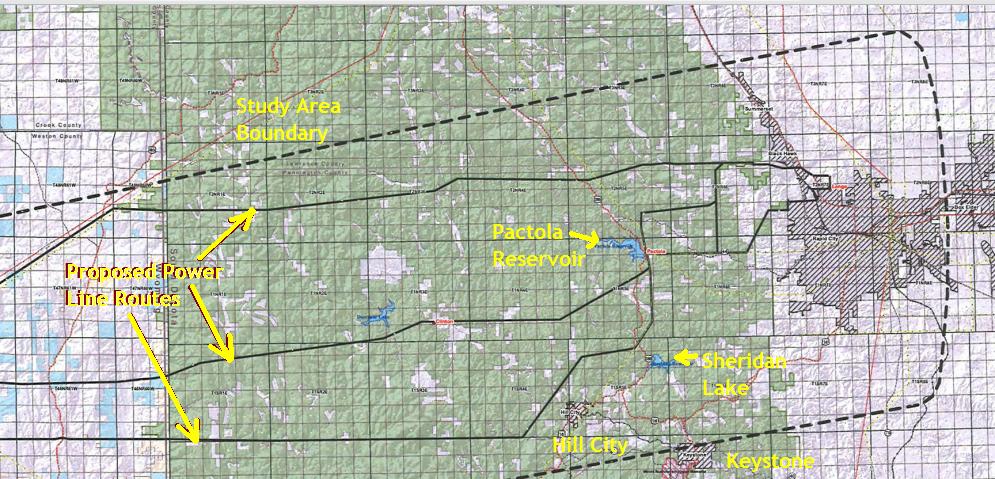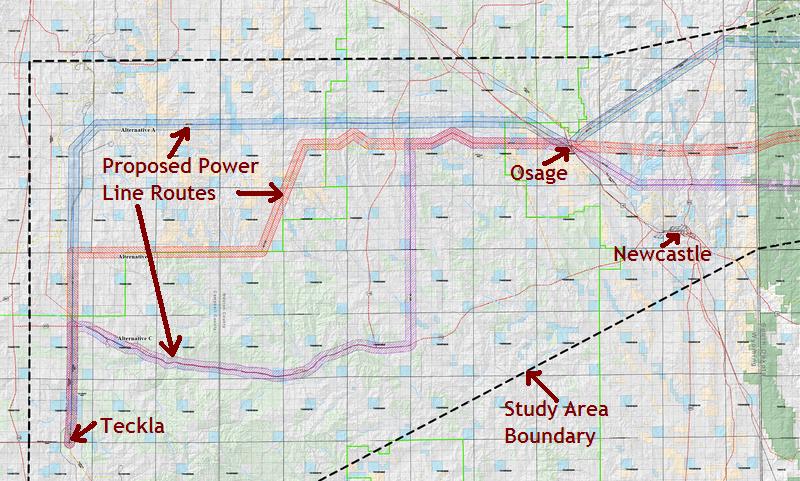Last updated on 2011.09.03
Black Hills Power wants to build about 150 miles of new power line from Wyoming to South Dakota. The Teckla-Osage-Rapid City Transmission 230 kV Project would bring (probably) coal-fired power from the Teckla and Osage Substations in northeastern Wyoming to the Lange Substation in Rapid City. On our side of the border, the line would cross the Black Hills National Forest and private land.
The Forest Service is thus taking public comment this month on what it should include in its environmental impact study of the transmission project. This first comment period runs through October 28.
Now I certainly don't want to sound like I oppose energy. Black Hills Power says this transmission project will, among other things, help meet growing demand and support economic development, which are quite reasonable justifications for a new power line. But I'm curious: how long could we put off sacrificing another strip of Black Hills forest and laying another right-of-way across private land if we didn't build the Keystone XL pipeline? The seven pumping stations that pipeline will need in western South Dakota will eat up a lot of electricity. Imagine how many homes and local businesses we could power with that electricity.
The Forest Service will note down that question and others relevant to BHP's proposed power line at two public meetings to take your comments:
- September 13, 2011, 4-7 p.m., Hell Canyon Ranger District Office, 1225 Washington Boulevard, Newcastle, WY.
- September 20, 2011, 6-8 p.m., Mystic Ranger District Office, 8221 South Highway 16, Rapid City, SD.
If you can't make the public meetings, you can send written comments to Dave Slepnikoff, Project Manager, Black Hills National Forest, 8221 South Highway 16, Rapid City, South Dakota 57702; or Geri Proctor, Thunder Basin National Grasslands, 2250 East Richards Street, Douglas, WY 82633-8922. Send comments via e-mail to comments-rocky-mountain-black-hills-mystic@fs.fed.us with ``Teckla-Osage-Rapid City Transmission Project'' as the subject. E-mails should be regular text, although you may also send Word and PDF attachments.
Update 2011.09.03 07:16 MDT: Stan Gibilisco serves the cause by providing a link to BHP's project description page, which includes really big maps of the proposed power line routes. The Teckla&ndashRapid City line cuts straight across the center of the Black Hills. Here's the South Dakota portion:

And here's the Wyoming portion:

Full maps from Black Hills Power:

transmission lines should be buried in highway rights of way where power can be tapped for transportation energy. Powerlines are unsightly, hazardous to raptors, and warp space/time by surreptitiously locking red states in the nineteenth century.
Boycott BHC. Throw the bums off your property.
Where can I find a map of the proposed route for the transmission line?
Couldn't wait for someone else to do my search for me, so I found this link for maps and other information. Enjoy (if that's the word):
http://www.blackhillspower.com/transmission/projects/index.htm
Good work, Stan! And Larry does make me wonder: why don't we bury all of our power lines? Is there room in existing rights of way? Is trenching more expensive up front? Would maintenance be more expensive?
Check out these two sites to learn more about transmission lines above and below ground:
http://en.wikipedia.org/wiki/Electric_power_transmission
http://www.atcllc.com/IT5.shtml#whydoesnt
Up to ten times the cost, harder repairs, less heat dissipation... thanks, Greg! I imagine blasting trenches into Black Hills granite would be no picnic. (Hmm... so I onwder how much extra cost Madison imposed on its electric consumers by burying those lines in the downtown alleys? Worth the price?)
Bury it. Use existing right of way infrastructure. Every power line right of way includes an implied road. The road is "necessary" to maintain the line. The road fragments habitats - especially for road-leary animals like elk and mule deer which are declining in the Black Hills and are documented as avoiding roads by a half mile. Overhead lines are very hazardous to eagles and birds by collisions and electrocuting. Perch preventors do not ban all perching. Power lines in LA and NYC are buried. When Irene hit NYC it caused virtually no damage to the cities grid. Power lines in my neighborhood are buried. Buried power lines are rarely eligible for federal FEMA bailouts - when it rains, when it snows, when the wind blows. Get over it. Move on. Tell the Forest Service the range of alternatives is unacceptable.